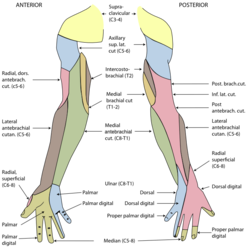Posterior cutaneous nerve of forearm
| Posterior cutaneous nerve of forearm | |
|---|---|
 Diagram of segmental distribution of the cutaneous nerves of the right upper extremity. Posterior view. ("post. antebrach. cutan." visible in red at right.) | |
| Details | |
| From | Radial nerve |
| Identifiers | |
| Latin | Nervus cutaneus antebrachii posterior, nervus cutaneus antibrachii dorsalis |
| TA98 | A14.2.03.052 |
| TA2 | 6434 |
| FMA | 39145 |
| Anatomical terms of neuroanatomy | |
The posterior cutaneous nerve of forearm is a nerve found in humans and other animals. It is also known as the dorsal antebrachial cutaneous nerve, the external cutaneous branch of the musculospiral nerve, and the posterior antebrachial cutaneous nerve. It is a cutaneous nerve (a nerve that supplies skin) of the forearm.
Origin
It arises from the radial nerve in the posterior compartment of the arm, often along with the posterior cutaneous nerve of the arm.
Course
It perforates the lateral head of the triceps brachii muscle at the triceps' attachment to the humerus.
The upper and smaller branch of the nerve passes to the front of the elbow, lying close to the cephalic vein, and supplies the skin of the lower half of the arm.
The lower branch pierces the deep fascia below the insertion of the Deltoideus, and descends along the lateral side of the arm and elbow, and then along the back of the forearm to the wrist, supplying the skin in its course, and joining, near its termination, with the dorsal branch of the lateral antebrachial cutaneous nerve.
See also
- Medial cutaneous nerve of forearm
- Lateral cutaneous nerve of forearm
- Posterior cutaneous nerve of arm
Additional images
-
Cross-section through the middle of upper arm.
-
Cutaneous nerves of right upper extremity.
References
![]() This article incorporates text in the public domain from page 944 of the 20th edition of Gray's Anatomy (1918)
This article incorporates text in the public domain from page 944 of the 20th edition of Gray's Anatomy (1918)
External links
- lesson5nervesofpostforearm at The Anatomy Lesson by Wesley Norman (Georgetown University)


